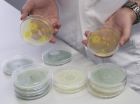Virus kills triple negative breast cancer cells, tumor cells in mice
2014-06-24
(Press-News.org) A virus not known to cause disease kills triple-negative breast cancer cells and killed tumors grown from these cells in mice, according to Penn State College of Medicine researchers. Understanding how the virus kills cancer may lead to new treatments for breast cancer.
Adeno-associated virus type 2 (AAV2) infects humans but is not known to cause sickness. In prior studies, the researchers tested the virus on a variety of breast cancers that represent degrees of aggressiveness and on human papillomavirus-positive cervical cancer cells. The virus initiated apoptosis -- natural cell death -- in cancer cells without affecting healthy cells.
"Treatment of breast cancer remains difficult because there are multiple signaling pathways that promote tumor growth and develop resistance to treatment," said Craig Meyers, Ph.D., Distinguished Professor of Microbiology and Immunology.
Signaling pathways involve molecules in a cell that control cell functions -- such as cell division -- by cooperation. For example, the first molecule in the process receives a signal to begin. It then tells another molecule to work, and so on.
Treatment of breast cancer differs by patient due to differences in tumors. Some tumors contain protein receptors that are activated by the hormones estrogen or progesterone. Others respond to another protein called human epidermal growth factor receptor 2, or HER2. Each of these is treated differently.
A triple-negative breast cancer does not have any of these protein receptors and is typically aggressive.
"There is an urgent and ongoing need for the development of novel therapies which efficiently target triple-negative breast cancers," Meyers said.
In the current study, the researchers tested AAV2 on a cell-line representative of triple-negative breast cancer. The researchers report their results in Cancer Biology & Therapy.
The AAV2 killed 100 percent of the cells in the laboratory by activating proteins called caspases, which are essential for the cell's natural death. In addition, consistent with past studies, AAV2-infected cancer cells produced more Ki-67, an immunity system activating protein and c-Myc, a protein that helps both to increase cell growth and induce apoptosis. The cancer cell growth slowed by day 17 and all cells were dead by day 21. AAV2 mediated cell killing of multiple breast cancer cell lines representing both low and high grades of cancer and targeted the cancer cells independent of hormone or growth factor classification.
The researchers then injected AAV2 into human breast cancer cell line-derived tumors in mice without functioning immune systems. Mice that received AAV2 outlived the untreated mice and did not show signs of being sick, unlike the untreated mice. Tumor sizes decreased in the treated mice, areas of cell death were visible and all AAV2 treated mice survived through the study, a direct contrast to the untreated mice.
"These results are significant, since tumor necrosis -- or death -- in response to therapy is also used as the measure of an effective chemotherapeutic," Meyers said.
Future studies should look at the use of AAV2 body-wide in mice, which would better model what happens in humans, according to Meyers.
INFORMATION:Other researchers on this project are Samina Alam, research associate, Penn State; Brian Bowser, PPD Vaccines and Biologics Laboratory; Mohd Israr, Feinstein Institute for Medical Research; and Michael Conway, Central Michigan University College of Medicine.
The Pennsylvania Breast Cancer Coalition funded this research.
ELSE PRESS RELEASES FROM THIS DATE:
Morphable surfaces could cut air resistance
2014-06-24
CAMBRIDGE, Mass-- There is a story about how the modern golf ball, with its dimpled surface, came to be: In the mid-1800s, it is said, new golf balls were smooth, but became dimpled over time as impacts left permanent dents. Smooth new balls were typically used for tournament play, but in one match, a player ran short, had to use an old, dented one, and realized that he could drive this dimpled ball much further than a smooth one.
Whether that story is true or not, testing over the years has proved that a golf ball's irregular surface really does dramatically increase ...
CNIO researcher Ana Losada revises the role of cohesin in cancer
2014-06-24
Massive sequencing of cancer genomes brings to light new genes every day that could be involved in the process of tumour formation. A good example of this is cohesin, a ring-shaped protein complex that embraces DNA to control cell division. Just a few months ago, and after several studies in the same direction, the sequencing of thousands of tumour samples identified the STAG2 gene—whose product forms part of cohesin—as one of the most frequently mutated genes in several types of cancer such as bladder cancer and melanoma.
The challenge now is to understand the link between ...
Quick, easy, inexpensive cortisol testing should soon be available on all smartphones
2014-06-24
CHICAGO, IL—Researchers have developed a device that uses any smartphone to measure the cortisol concentration in saliva. The device was presented Tuesday, June 24, at ICE/ENDO 2014, the joint meeting of the International Society of Endocrinology and the Endocrine Society in Chicago.
"We have developed a method for measuring cortisol in saliva using a smartphone and a disposable test strip. This innovation enables anyone with a smartphone to measure their salivary cortisol level quickly, accurately, and affordably," said lead study author Joel R. L. Ehrenkranz, MD, director ...
Sweet sweet straw
2014-06-24
This news release is available in German. Erythritol has many great advantages: it does not make you fat, it does not cause tooth decay, it has no effect on the blood sugar and, unlike other sweeteners, it does not have a laxative effect. In Asia it is already widely used and it is becoming more and more common in other parts of the world too. Up until now, erythritol could only be produced with the help of special kinds of yeast in highly concentrated molasses. At the TU Vienna, a method has now been developed to produce the sweetener from ordinary straw with the help ...
Expert outlines challenges of visual accessibility for people with low vision
2014-06-24
June 24, 2014 – New approaches and tools are needed to improve visual accessibility for people with low vision in the "real world," according to a special article in the July issue of Optometry and Vision Science, official journal of the American Academy of Optometry. The journal is published by Lippincott Williams & Wilkins, a part of Wolters Kluwer Health.
Vision science, in collaboration with other professions, has a key role in developing technologies and design approaches to promote visual accessibility for the millions of people living with low vision, according ...
Experts cite 'misconceptions' on brain metastases
2014-06-24
June 24, 2014 – "Key historical misconceptions" are hindering progress in research and treatment for patients with cancer metastases to the brain, suggests a special article in the July issue of Neurosurgery, official journal of the Congress of Neurological Surgeons. The journal is published by Lippincott Williams & Wilkins, a part of Wolters Kluwer Health.
Dr. Douglas Kondziolka of NYU Langone Medical Center and coauthors identify some issues that may be standing in the way of optimal clinical management for patients with cancer that has spread to the brain from other ...
New transdermal SARM drug for muscle-wasting offers hope for older cancer patients
2014-06-24
CHICAGO, IL—Muscle wasting that occurs as a result of cancer negatively impacts the well-being and recovery prospects of millions of patients, particularly the rapidly-growing elderly populations in Western societies. Drugs called selective androgen receptor modulators (SARMs) offer hope for these patients, and a new SARM for transdermal administration is promising excellent efficacy without harming liver function and HDL levels. Results and conclusions were presented Tuesday at the joint meeting of the International Society of Endocrinology and the Endocrine Society: ICE/ENDO ...
Gender differences could mean more risk for cardiovascular death
2014-06-24
Queen's University assistant professor Pendar Farahani (Department of Medicine and Department of Public Health Sciences) is advocating the use of gender-based treatment for mitigating the cardiovascular risk factors related to diabetes.
Research has shown women with Type 2 diabetes and high cholesterol are less likely than their male peers to reach treatment goals to lower their bad cholesterol, or low-density lipoprotein (LDL) cholesterol.
"The findings suggest the need for gender-based evaluation and treatment of cardiovascular risk factors in these patients," says ...
Study finds high CD4 cell counts associated with reduced risk of ischemic stroke for those with HIV
2014-06-24
OAKLAND, Calif., June 24, 2014 — A 15-year study found that HIV-positive individuals had a 40 percent increased risk of ischemic stroke, however stroke rates were nearly the same for HIV-positive individuals with high CD4 cell counts as for HIV-negative subjects.
The study, published recently in AIDS, the official journal of the International AIDS Society, covered the years 1996 through 2011 and included nearly 25,000 HIV-positive individuals.
Ischemic stroke is caused by plaque build-up in blood vessels, which can lead to constriction or actual obstruction of blood ...
Bizarre parasite from the Jurassic
2014-06-24
Around 165 million years ago, a spectacular parasite was at home in the freshwater lakes of present-day Inner Mongolia (China): A fly larva with a thorax formed entirely like a sucking plate. With it, the animal could adhere to salamanders and suck their blood with its mouthparts formed like a sting. To date no insect is known that is equipped with a similar specialised design. The international scientific team is now presenting its findings in the journal "eLIFE".
The parasite, an elongate fly larva around two centimeters long, had undergone extreme changes over the ...

